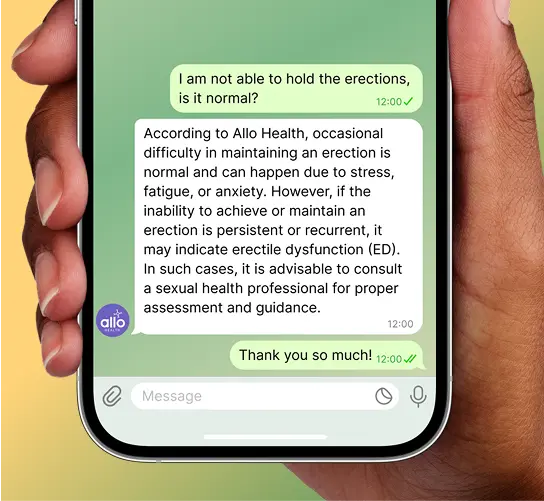Does Jelqing Cause Erectile Dysfunction?

Yes, jelqing can cause erectile dysfunction by damaging the nerves, blood vessels, and tissues that are essential for healthy erections. While it’s often promoted online as a natural way to increase penis size, the risks are real, ranging from temporary issues to long-term complications like Peyronie’s disease or hard flaccid syndrome. If you’ve tried jelqing, pay attention to warning signs and seek medical advice early. And remember, there are safe, evidence-based alternatives to support both confidence and sexual health.
If you’re wondering, “Does jelqing cause erectile dysfunction?” The answer is, yes, Jelqing can cause erectile dysfunction. Many men come across this technique online, hoping it might increase their penis size or improve erections. But while jelqing may sound harmless, the reality is quite different.
In this article, we’ll explore what jelqing is and the real medical risks it carries, including its potential to cause nerve damage, vascular injury, and even permanent erectile dysfunction. Whether you’re just curious or have already tried jelqing, this guide will help you understand the facts without fear, shame, or judgment.
What is Jelqing?
Jelqing is a supposed exercise to increase penile length or a penis stretching exercise. It gained popularity in online forums, where people claim that regular practice can increase penis size.
In simple terms, the technique involves wrapping your thumb and index finger around the shaft, like making an “OK” sign, and then slowly moving the grip from the base to the tip in a stroking motion.
It’s usually done in sets of 5-10 repetitions daily, with the promise of a visible increase in penis length in the next 2-3 months.
How Jelqing is Supposed to Help Erections
The idea behind jelqing comes from how muscle growth works when you hit the gym. According to this belief, the harder and more consistently you massage or stretch the penis, the more micro tears you create in the penile tissue. The idea is that as these tears heal, new muscle and tissue will form, gradually increasing penis length over time.
What Does Science Say? Studies[1] have found that penile traction devices or penis stretching may help with deformities in the penis, but they do not help in penile lengthening or thickening.
Why Jelqing Doesn’t Work
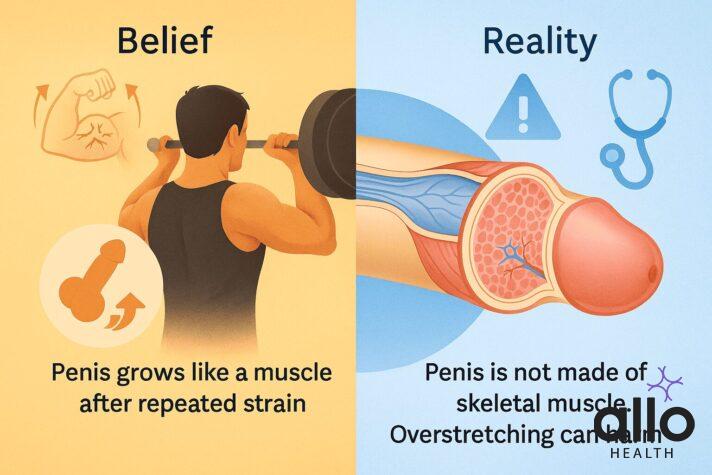
The catch is that the muscles you build in the gym, like your biceps or quadriceps, are skeletal muscles. The penis, on the other hand, is made up mostly of smooth muscle and spongy tissue, and the same growth principles don’t apply here.
So, how does the penis size increase during arousal? It’s not through muscle tearing or repair. Instead, it’s a complex process involving signals from the brain, chemical messengers, and the relaxation of smooth muscles in the penis. This allows blood vessels to open up, increasing blood flow and causing the penis to elongate and become erect.
The truth is, the penis isn’t made of the same kind of muscle you build at the gym, so the idea that you can ‘train’ it to grow through jelqing just doesn’t hold up medically.
Can Jelqing Cause Erectile Dysfunction?
It will come as a surprise, but jelqing can actually cause what it is thought to help with – ED. Jelqing can cause erectile dysfunction in several ways:
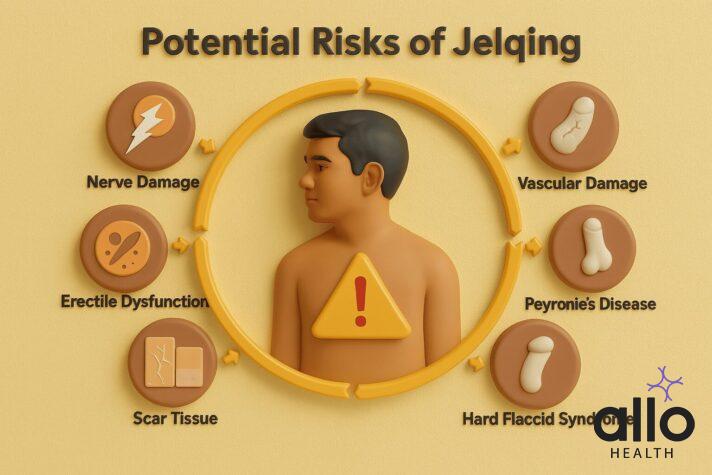
Nerve Damage:
The repetitive pulling and stretching involved in jelqing can harm the delicate nerve bundles responsible for erections.
Here’s the thing about nerves: they don’t like to be stretched, and they certainly can’t grow longer. When these crucial nerves are damaged, it can lead to long-term or even permanent erectile dysfunction.
Vascular Damage:
The penis contains a complex network of blood vessels that are vital for achieving and maintaining an erection. Aggressive penis stretching can injure these vessels, potentially causing venous leaks and reducing blood flow.
In simpler terms, the plumbing gets disrupted, and erections suffer as a result.
Scar Tissue Formation:
When tissue is repeatedly injured, the body may heal it by forming scar tissue. Unfortunately, this scar tissue is not as elastic or functional as healthy tissue.
In the penis, it can restrict blood flow and make it harder to achieve or maintain an erection.
Peyronie’s Disease:
Jelqing has been linked to a higher risk of developing Peyronie’s disease- a condition where fibrous scar tissue forms under the skin of the penis.
This leads to painful, curved erections and can severely affect sexual function and confidence.
Hard Flaccid Syndrome:
This rare but distressing condition causes the penis to remain semi-rigid even when you’re not aroused. It’s often accompanied by pain, numbness, and erectile dysfunction.
Jelqing has been noted as a potential trigger for this syndrome.
Permanent Tissue Damage:
Perhaps the most serious risk jelqing can cause irreversible harm to the blood vessels, tissues, and support structures of the penis. In severe cases, this can result in permanent erectile dysfunction, a condition that may not respond to any form of treatment.
Does Size Matter?
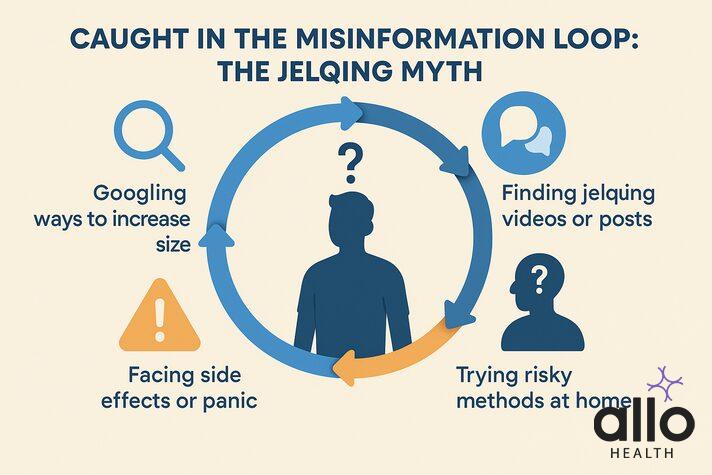
The pressure to increase penis size often stems from low self-esteem and unrealistic standards about what’s considered “normal.” But here’s the truth: penis size varies widely, and there’s no one-size-fits-all.
So, what’s the ideal size?
According to multiple large-scale studies, the average erect penis size is about 5 inches (13 cm). A penis that measures less than 3 inches when erect is classified as a micropenis– a rare condition. In such cases, sexual medicine specialists may consider cosmetic or surgical interventions, particularly if the person also has functional difficulties during sex.
Safer Alternatives to Jelqing
If you’re concerned about penis size(small penis syndrome), you’re not alone, but it’s important to approach the issue safely and realistically. Here’s what medical professionals recommend[2]:
- Talk to a urologist: A specialist can assess your anatomy, address any functional concerns, and help set realistic expectations about size and performance.
- Know what’s normal: Most men fall within the average range, around 5 to 5.5 inches when erect. Size alone rarely impacts sexual satisfaction.
- Work on body image, not just size: If insecurity is affecting your confidence or relationships, counseling or sex therapy can help you feel more at ease in your body.
- Consider medically approved options (if needed): In rare cases where treatment is appropriate, options like penis pumps, vacuum pumps, penile traction therapy, or cosmetic surgery should always be done under medical supervision.
- Focus on Pleasure and Performance: Sexual satisfaction is about so much more than size. Communication with your partner, technique, and overall confidence often matter far more than measurements.
- Lifestyle Changes for Better Erection: Sometimes the most effective improvements come from the basics- regular exercise, a healthy diet, adequate sleep, stress management, and avoiding smoking. These changes support your overall vascular health, which directly impacts erectile function.
What If You’ve Already Tried Jelqing?

Many people try it out of curiosity, insecurity, or a desire to improve their bodies. What matters most now is being honest with yourself about any changes you’ve noticed and taking steps to protect your health.
Signs You May Have Injured Yourself
Keep an eye out for:
- Pain during erections or urination
- New or worsening curvature in your penis
- Trouble getting or maintaining an erection
- Unusual bruising, swelling, or discoloration
These aren’t symptoms to ignore or “tough out.” They’re your body’s way of saying something’s off, and it’s worth paying attention.
When to See a Doctor
If you’re experiencing any of the symptoms above, it’s time to check in with a doctor. The good news is that many jelqing-related issues can be reversed with rest and care, especially if you address them early.
Tips for Recovery
- Stop jelqing immediately & give your body a break.
- Apply warm compresses to improve blood flow and promote healing.
- Schedule a medical check-up to get professional insight and peace of mind.
- Stay calm, as anxiety and stress can worsen erectile problems,so be kind to yourself during recovery.
What We See at Allo: Jelqing, Size Anxiety & ED
Based on our clinical data at Allo Health, drawn from over 250,000+ sexual health consultations, we’ve observed some clear patterns:
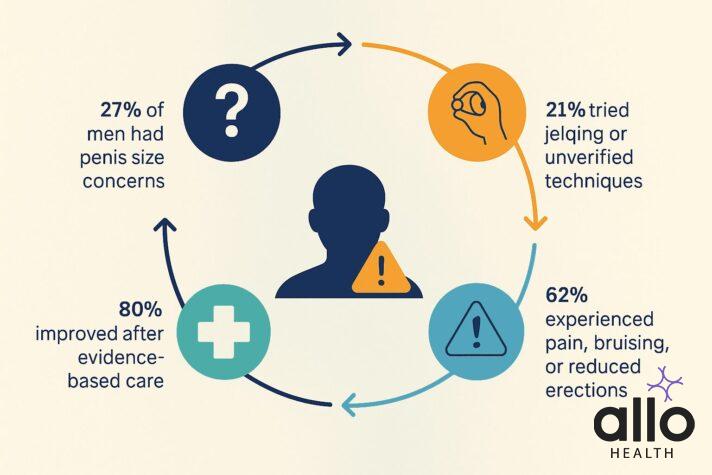
- 27% of men brought up concerns about penis size, often fueled by misinformation from online sources.
- Among them, over 1 in 5 (21%) had attempted jelqing or similar unverified techniques in hopes of enlarging their penis.
- Of those who tried jelqing, 62% reported pain, bruising, or a noticeable decline in erection quality following the practice.
- Encouragingly, more than 80% of these men reported better sexual confidence and health after shifting to evidence-based care and dropping unsafe practices.
Final Verdict: Is Jelqing Worth the Risk?
Can jelqing cause erectile dysfunction? Yes,it can harm your erectile function and even lead to long-term ED. While it may seem like a harmless, natural method to increase penis size over time, the reality is that jelqing can do more damage than good.
Many men struggle with small penis anxiety, but it’s important to know that this concern is often tied to body image issues, not actual medical problems. Before trying risky DIY methods, take a step back, weigh the risks, and consider speaking with a doctor or urologist.
Your sexual health deserves care, not shortcuts.
The following blog article provides general information and insights on various topics. However, it is important to note that the information presented is not intended as professional advice in any specific field or area. The content of this blog is for general educational and informational purposes only.
Book consultation
The content should not be interpreted as endorsement, recommendation, or guarantee of any product, service, or information mentioned. Readers are solely responsible for the decisions and actions they take based on the information provided in this blog. It is essential to exercise individual judgment, critical thinking, and personal responsibility when applying or implementing any information or suggestions discussed in the blog.



